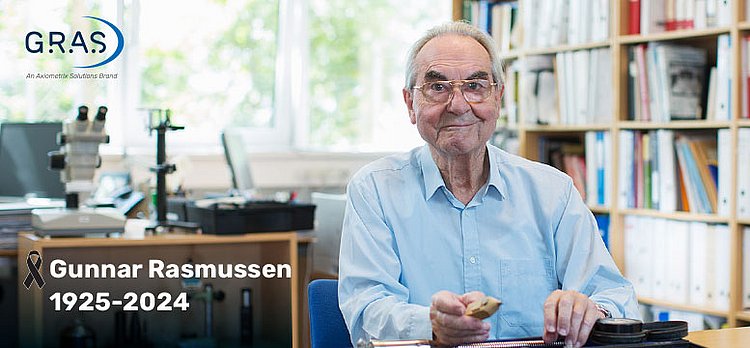The founder of GRAS Sound & Vibration, the renowned acoustical engineer Gunnar Rasmussen, passed away on the 17th of April 2024.
Already as an engineering student, Gunnar Rasmussen exhibited great talent, and shortly after his final exam, he was hired by the Danish acoustics company Brüel & Kjær. In the 1950s, he was sent to the USA to market products and handle after-sales service on the American market. The inquisitive microphone specialist took the opportunity to learn everything he could about the technologies that were emerging in the acoustical industries in the USA, and to build networks across a wide range of industries.
World-Class Precision and Durability
In the 1950s, the automotive, aviation, and electronics industries were rapidly growing in the USA, and there was an increasing demand for more and better measurement microphones. Through Gunnar Rasmussen’s involvement in various acoustic measurement projects, he realized there was room for improvement in the measurement microphones that were currently available on the market. So, when Gunnar returned to Denmark, he began to develop a new generation of measurement microphones. The result was a new and revolutionary simple design, which for the last 60 years has been the preferred type of measurement microphone for all kinds of acoustic measurements and has become an international standard.
GRAS Sound & Vibration
At the age of 67, when most people head for retirement, Gunnar Rasmussen left Brüel & Kjær and founded GRAS Sound & Vibration in 1994. Initially, the company was a small family business, run by Gunnar Rasmussen and his wife Hanna Hertz, but in a short time, the company grew into a respected and leading manufacturer of measurement microphones, where many of the founder’s new ideas and inventions became commercial successes. Today, the company – which now has around 90 employees and is part of the international Axiometrix Solutions group, - sells more than 100 different types of microphones and measurement solutions and has sales offices and authorized partners around the world.
Honors and Recognitions
Gunnar has been chairman of the ISO committee, honorary member of the American Acoustical Society (ASA), and has received the prestigious Danish Design Award for his design of measurement microphones and sound meters. The famous conductor Leonard Bernstein once approached Gunnar Rasmussen for help acquiring a better microphone for recording classical music. Gunnar Rasmussen has also received a CETIM medal and an IEC Award. In 2008, Gunnar received the European Acoustics Association's prestigious "Lifetime Achievements in Acoustics" award.
Gunnar Rasmussen milestones:
1956 The 1” microphone is developed. It has superior stability both mechanically and regarding temperature. The design of the microphone quickly becomes the de facto standard for acoustic measurements, and forms the basis of the IEC 1094-series of international standards for measurement microphones
1960 The first acoustically optimised sound level meter (Type 2203) is developed. The shape of the housing is designed to minimise the effect of cabinet diffractions. For many years, it is considered the archetype of sound level meters.
Early 1960s By measuring the characteristics of the human ear with a 1/8” microphone, it is possible to create the basis and design of what is known today as the artificial reference ear (711 coupler/occluded ear simulator). The international standard for this is based on Gunnar Rasmussen’s data and design.
1963 The Dual-piston calibrator (pistonphone) makes it possible to calibrate measurement microphones precisely. Once again, the design becomes the de-facto standard of how a precision calibrator should be made.
1964 Gunnar Rasmussen is granted the Danish Design Award for the design of the Sound Level Meter Type 2203.
Mid 1960s The development and design of an artificial mouth, which becomes the basis of an international ITU standard.
1969 Gunnar Rasmussen achieves the Danish Design Award for his innovative design of the 1”, 1/2”, 1/4” and 1/8” measurement microphones. The 1” measurement microphone is exhibited at the Museum of Modern Art in New York, MOMA.
Late 1960s The design of underwater microphones is realised, and the first precision hydrophones are developed.
The 1970s Piezo-electric accelerometers are further developed. Due to Gunnar Rasmussen’s DeltaShear-design, significant improvement of the accelerometer’s performance is achieved. The design is patented.
1977 Gunnar Rasmussen becomes Chairman of the committee “ISO TC108/SC3 Shock and Vibration Instrumentation”.
1980s Gunnar Rasmussen makes it possible to measure sound intensity by creating a sound intensity probe with a face-to-face design and an associated measuring system and calibration method. With this solution, it was possible to locate and map sound sources.
1982 Gunnar Rasmussen is accepted as a Fellow of the Acoustical Society of America.
1984 Gunnar Rasmussen is elected Vice Chair of The International Commission for Acoustics – a subcommittee of the International Union of Pure and Applied Physics.
1990 Gunnar receives the CETIM award for his knowledge and contribution within the field of sound intensity.
1994 Gunnar Rasmussen founds GRAS Sound & Vibration with his spouse Hanna Hertz.
2008 Gunnar Rasmussen receives the prestigious award “Lifetime Achievements in Acoustics” - European Acoustics Association.
2011 The International Electrotechnical Commission, IEC,grants Gunnar Rasmussen the IEC Award









